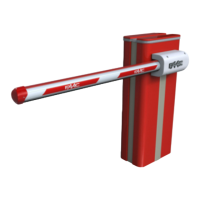Fig. 4
B680H 20 732719 - Rev.D
J6
J12
J11
J14
J17
W
W
SW
J18
J1 J2
J3
J4
L
L
L1
L1
L1
L1
L14
L1
L
L9
L
L4
L1
Eas
BU
PE
CL
S
W
ST
MR
ND
4
9
7
9
4
4
4
4
T
T
T
ND
AM
P
P
NC
DER
I
P
L
L1
W4
N
C
J16
W
T
T
Translation of the original instructions
ENGLISH
6.4 “Expert” default parameters
The following table contains the pre-defined settings that characterize
the various operation logics.
Step AA1E PPACnCaC
01
YYNNYNYN
02
NNNYYYYY
03
NNNNNNNN
04
NNNNNNNY
05
NNYNNNNN
06
NNYNNNNN
07
NNNNNNNN
08
NNNNNNNN
09
NNNNNNNN
10
NNNNNNNY
11
NNNNNNNN
12
NNNYYNNN
13
NNNNNNNN
14
NNNYYYYN
15
NNNNNNNN
16
NNNYYNNN
17
NYNNNNNN
18
NYNNNNNN
19
NNNYYNNN
20
NYNYYYYN
21
N Y NYYYYN
22
NNNNNNNN
23
NNNYYNNN
24
NNNNNNNN
25
NNNNNNNN
26
NNNNNNNN
27
NNNNNNNN
28
NNNNNNNN
29
NNNNNNNN
30
NNNNNYYN
7. START-UP
7.1 Verifying the diagnostic LEDs
Before starting up the board, it is necessary to verify that the status
of the diagnostic LEDs corresponds to the logic. Said status must
coincide with the indications in Fig. 4, situation which reflects that of
an automated system that is CLOSED and ready to open.
The FSW, STOP and ALARM LEDs are safety inputs with
NC contacts, therefore the related LEDs must be ON
when the automated system is at rest, and go off when
the device connected is engaged.
The OPEN and CLOSE inputs are NO contact inputs,
therefore the related LEDs must be OFF when the
automated system is at rest, and go on when the device
connected is active.
The BUS status must correspond to DL2 (green) on fi xed
and DL1 (red) off. The BUS menu of the
BASIC programming must display the
indication shown to the side confi rming
the fact that there are no engaged
photocells or active pulse generators.
7.2 Setup
Before being put into operation, the E680 board requires a setup
procedure during which the automated system determines the rotation
angle of the beam and consequently its travel. These measurements
allow correct management of motor decelerations and acceleration
ramps.
At fi rst start-up the board will signal the need for a setup
cycle, by displaying a fl ashing
S0.
For setup, proceed as follows:
1. Using the parameter “Mt” in BASIC programming mode, check that
the opening / closing movement corresponds to the pressed key (+
/ -); if not, go to the motor wiring and reverse the two conductors
L1 and L3, as shown in Fig. 14, Ref. d
2. Bring the automation system to the fully closed position with the
“Mt” parameter of the Base configuration level or by operating
the release device as indicated in sections 6 and 7 on page 4.
3. Access Base programming and repeatedly press the F button until
you reach the parameter
tL, then press the + and - buttons at the
same time until the automation system begins opening slowly.
During setup, a fl ashing -- indication will appear on the
display.
4. On reaching the fully open position, the automation system will
stop automatically.
5. The automation system will then begin the beam closing
movement.
6. On reaching the closed position, the automation system will stop
automatically.
7. Press the F button to exit the procedure, and confirm you wish to
save the data with the parameter
St. Check that the status of the
automation system shown on the display is
00 (closed) and that
the rod is in the closed position. If the rod is open and the display
is showing
00, check / adjust the correct direction of movement
of the motor again as in step 1 of the procedure.
8. TESTING THE AUTOMATED SYSTEM
Once programming is completed, ensure that the system is operating
correctly.
Verify especially the correct regulation of the automated system power
and correct operation of the safety devices it is connected to and verify
that the automated system conforms to current safety standards.

